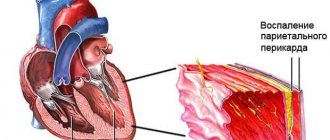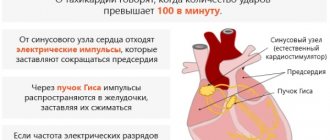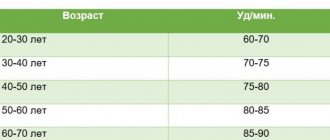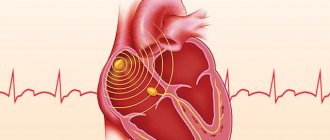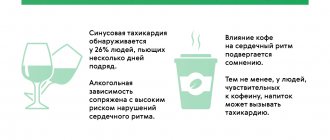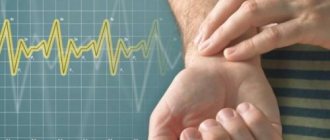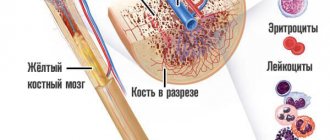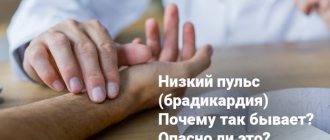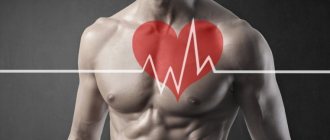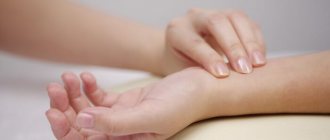Heart rhythm disturbances are represented by a group of deviations from the norm. Mostly we are talking about sinus tachycardia and the reverse process, a decrease in heart rate. Basically, they do not pose a threat to health or life, but variations are possible. Violation of the contraction frequency at the level of 50-60 is considered moderate bradyardia.
In some cases, the pulse is 55 beats. per minute - This is fine. Classic examples are athletes, professional manual workers, tall people and others. It is necessary to understand each case separately.
However, physiological (good) factors account for up to 10% of all identified situations. Therefore, the main assumption when a patient is admitted is the pathogenic process. Even the refutation of this hypothesis provides grounds for further searches.
Treatment is prescribed as needed. Products based on eleutherococcus, ginseng, and tonics with caffeine are used. In extreme cases, the use of Epinephrine and Adrenaline is indicated. As the deviation progresses.
The prognosis is almost always favorable. With rare exceptions. The inability to radically influence the patient’s position is associated with organic, anatomical causes of the condition.
In what case is such a pulse normal?
In a minimum number of situations we are talking about an adequate level of 55 beats per minute. Pulse 55-58 occurs in the following conditions:
- Dream. During a night's rest, the body goes into a gentle mode of functioning. The concentration of adrenaline, cortisol, hormones of the adrenal cortex, pituitary gland, and also substances responsible for vasoconstriction and increased blood pressure decreases. Therefore, the heart rate drops.
This is a normal process and does not require assistance. In exceptional cases, heart rate reaches 40-45 beats per minute. This is an acceptable option; specialized measures are not needed.
Normally, a person is not aware of a decrease in cardiac activity at night. This is usually a finding obtained as a result of 24-hour Holter monitoring. If there are no sharp changes in the graph, everything is fine.
- Body fitness. Primarily characteristic of male athletes. As a result of excessive activity, the heart modifies itself. Builds muscle mass.
Constant overload leads to an increase in contractility. In one systole, the organ pumps much more blood than the average person, regardless of gender.
Accordingly, there is no need to intensify functioning. Heart rate drops and remains at 50-55 beats at rest, always. Further changes indicate cardiac problems. Athletes need to be monitored at all times.
- Decreased body temperature. We are talking about a reflex weakening of cardiac activity. This is not dangerous for short-term exposure to unfavorable conditions.
If you lose consciousness in the cold (for example, after drinking alcohol or the onset of an emergency), while in water, the likelihood of cardiac arrest is high.
The cases can thus be counted on the fingers of one hand. All other situations are pathological and require treatment.
Therefore, diagnosis, differentiation between norm and deviation is simplified. Electrocardiography, changes in basic indicators and observation for at least 2 months are indicated, with a frequency of 1 time per 2 weeks.
Recommendations from experts
- A drop in heart rate during the day or at night can be either a physiological (meaning normal and not dangerous) or a pathological condition.
It is better to consult a doctor in advance, without waiting for disturbances in the body and cardiovascular system.
- You can increase your pulse rate with medications and folk remedies; it is only important to understand that neglect of such a symptom is fraught with serious consequences.
- A healthy lifestyle will help normalize your heart rate
- In order to combat and prevent heart rate abnormalities, it is necessary to optimize your lifestyle.
- Lack of physical activity and sedentary work can cause a decrease in heart rate.
- Daily walks in the open air, simple morning exercises and a cool shower work no worse than medications.
- There is no need to exhaust yourself with training. It is enough to walk 2 kilometers in the morning and evening, and the result will certainly appear.
- A prerequisite for recovery is adherence to sleep and rest patterns.
- Nutrition should be radically revised:
- less fatty foods, which cause the progression of atherosclerosis;
- more plant fiber, dairy products, fish and greens.
- The drinking regime should include the consumption of a sufficient amount of liquid. This will ensure that the vessels are filled with a good volume of circulating blood, increase blood pressure and normalize the pulse rate.
Sex and age characteristics
Another clinically possible option is a pulse of 55-56 beats per minute in women. Development factor - gestation or menstrual cycle. Both processes are associated with hormonal imbalances, deviations in the direction of decrease or imbalance with a predominance of progesterone.
In adolescents, bradycardia is observed during puberty. Puberty makes the disorder unstable. Over the course of several hours, the heart rate either drops or rises sharply. Patients with such symptoms should be constantly monitored.
This is not a pathology, but it is not the norm either. We are talking about borderline states that can result in something dangerous. Consultations with a cardiologist, ECG every 2 months during gestation, and once every six months at the height of puberty are indicated.
Folk remedies for low heart rate
To increase your heart rate without drugs and health risks, alternative medicine has some effective recipes.
Some of them are accepted and even recommended by official medicine, for example:
Lemon - citrus strengthens the vascular wall, cleanses blood vessels of toxins and toxins, improves immunity, so for such problems you should regularly consume fresh lemon, add it to tea, take fresh juice and season dishes with it.
Walnuts – due to the content of Omega-3 fatty acids, blood pressure and the functioning of the cardiovascular system as a whole are normalized. Nuts should also be consumed regularly in small portions.
Dried apricots – this dried fruit cleanses blood vessels and prevents their blockage, and also lowers blood pressure, so you need to get into the habit of eating dried apricots regularly.
Radish juice with honey – the core of the black radish needs to be removed from the vegetable, and a little honey should be put inside. After a day, juice will appear there, which you need to drink several times a day, 20 grams each.
Pine tincture - young pine shoots are washed, crushed, then a tablespoon of raw material is diluted in a glass of alcohol. The mixture must be kept for 10 days in a dark place, after which take 20 drops 1-2 times every day.
Lemon and garlic - squeeze the juice out of five lemons into a glass container, and add 5 squeezed heads of garlic there. The mixture is infused and 20 grams of the product are drunk before each meal for a month.
Red wine - you need to boil a homemade drink, add cumin, cinnamon and honey, mix the composition thoroughly and drink 30-50 grams daily.
Yarrow decoction - the herb in the amount of 1-2 spoons is brewed with a cup of boiling water, infused under a lid and filtered to remove sediment. You need to take a cup of decoction in several parts per day.
Rose hips - a decoction must be prepared from the fruits of the plant in the standard way. Next, grind any sour berries, add to the broth and sweeten with natural fresh honey.
Herbal collection - in the same proportions combine coffin, calendula, valerian, sedum, wormwood, and Echinaceae. A couple of tablespoons of the mixture are brewed in 500 ml of boiling water and simmered a little in a water bath. The strained broth is taken in 100 g doses. a couple of times a day.
An alternative way to speed up the heartbeat and pulse is to apply mustard plaster to the area to the right of the heart.
You need to keep it for no longer than 3 minutes, so as not to overdo it and cause a skin burn.
You can start using home remedies, even the most harmless ones, only with the permission of your doctor. There are many proven recipes to increase tone. But if the reasons for the decrease in heart rate are unknown and there was no consultation with specialists, folk remedies cannot be used.
Another contraindication to any home methods is the period of pregnancy. It is not recommended to use even proven remedies on your own during pregnancy.
When is this not normal?
In the vast majority of cases. What are the causes of rhythm disturbances such as bradycardia?
Inflammation of the heart muscle
Myocarditis. It is an infectious disease (as a common complication of tonsillitis), and extremely rarely an autoimmune disease with an acute course.
It is rarely chronicled, mostly limited to one episode over the course of many years. The danger lies in the rapid destruction of tissues and destruction.
If you do not react in time, the consequences will be catastrophic: necrosis, scarring, and other delights in the spirit of a massive heart attack.
Requires hospitalization in a specialized department, administration of antibiotics in loading doses, and detoxification. In extreme cases, surgery and prosthetics are prescribed.
Attention:
Bradycardia occurs in half of the situations. The other part is due to increased heart rate.
Previous heart attack
Acute necrosis of muscle tissue. It is developing rapidly. In the early rehabilitation period it gives symptoms of bradycardia (52-55 beats per minute).
Treatment as such is not necessary; it is recommended to monitor the patient, adjusting the heart rate with medications if necessary. But using gentle methods.
Any rapid changes can provoke cardiac arrest, recurrent heart attack and death of the patient.
Liver diseases
Presented by a large group of reasons. A pulse of 55 beats per minute occurs in general, advanced lesions, for example, cirrhosis in the sub- and decompensation phase.
The causes are diverse; there is a group of pathological factors. As the functional activity of the organ is restored, the problem disappears. Long-term, in some cases permanent, therapy for hepatonecrosis is required.
Hypothyroidism
Decreased concentrations of thyroid hormones. The reverse process (hyperthyroidism) is less common.
Accompanied by a host of additional symptoms. Shortness of breath, impaired consciousness, obesity with the inability to lose excess weight using conventional methods, a drop in blood pressure and temperature.
The correction is planned, under the supervision of an endocrinologist. In general, the problem can be solved relatively easily and quickly.
Insufficient amounts of adrenal hormones
Or Addison's disease, resulting from injuries or congenital anomalies. But more often after undergoing surgery to remove tumors, such as pheochromocytoma.
It is assumed that hormones – synthetic analogues – will be used continuously. To restore normal organ function.
For resection, the dosage is lower. Total excision requires lifelong medication. A critical drop in hormone levels affects the risks of cardiac arrest and death.
Infectious pathologies
A heartbeat of 55 beats can occur with diseases ranging from colds to syphilis, tuberculosis, and typhoid fever, which is relatively rare these days. Also viral diseases: cytomegaly, mononucleosis, AIDS and others. These are not obvious factors; few people assume the existence of such a problem.
Change in blood pressure
Sudden changes in blood pressure can lead to a reflex disturbance in heart rate. This is a temporary phenomenon, but it poses a tremendous danger to the patient’s life.
Correction of the underlying condition is required to avoid future disorders and reduce the risk of death.
Taking medications
Antiarrhythmics, glycosides, neuroleptics, tranquilizers, antidepressants, NSAIDs, glucocorticoids and others provoke disturbances in myocardial conduction.
The condition is potentially lethal; in the absence of correction, it ends in asystole and death in 30-40% of cases.
If violations are detected, it is recommended to contact your treating specialist again to change the course of therapy.
Intoxication
Products of tumor decay (malignant neoplasia always lead to poisoning), alcoholic beverages (ethanol and impurities, fusel oils, other chemicals), also salts of heavy metals, and other drugs.
Blockage of the heart pathways
Perhaps the most dangerous reason among those listed. Normally, the sinus node (a special collection of cardiomyocytes) generates an electrical impulse.
It moves in the direction of the ventricles, leading to a uniform contraction of the entire muscle layer. The signal passes through the His bundle. As a result of the blockade of its legs or the clusters themselves, a disturbance in the heart rate occurs.
When the functional activity of the sinus node deviates, the risk of death increases, heart rate drops below 50 beats per minute.
In order to somehow compensate for the violation, the ventricles and atria begin to contract independently, chaotically. The release of blood does not improve, the process goes in cycles.
This condition requires urgent medical attention. At the same time, it is impossible to detect a violation at an early stage; electrocardiography is necessary.
Nervous causes
We are mainly talking about vegetative-vascular dystonia. There is no official diagnosis; as many doctors say, signs of this symptom complex are found in anxiety disorders, depression, and panic attacks. The question is controversial. But psychosomatics is also possible.
Osteochondrosis of the cervical spine
And, as a result, compression of the basilar artery. The process leads to malnutrition of the brain, which sends chaotic signals, which affects the heart rate.
In the absence of data for organic pathologies, natural factors are sought. If there are none, the idiopathic form is stated.
In such a situation, treatment is only symptomatic, with the use of tonic medications. Usually the cause turns out to be insignificant, and there is no death.
Causes of decreased heart rate
Physiological factors:
- sleep at night
- exposure to low temperatures
- hormonal imbalances during adolescence
- professional sports
Heart diseases:
- ischemia of the heart muscle
- myocardial infarction
- heart failure
- cardiomyopathy
- myocarditis
- heart defects - congenital, acquired
Toxicological factors:
- acute intoxication of the body
- indiscriminate use of medications, in particular diuretics, cardiac and blood pressure stimulants
- Lack or excess of ions (potassium, magnesium, sodium, calcium) in the body negatively affects the heart
- smoking, drug use, alcoholic beverages
Other diseases and conditions that can lead to low heart rate:
- vegetative-vascular dystonia.
- anemia
- respiratory diseases - bronchitis, asthma
- intracranial pressure against the background of edema, hemorrhage, neoplasms in the brain
- severe infectious diseases - hepatitis, typhoid fever, diphtheria, meningitis
- diseases of the endocrine system - diabetes mellitus, dysfunction of the thyroid gland, adrenal function
What can you do at home?
Little. It is not known what caused the violation. Therefore, any amateur activity is excluded. An ambulance is required.
If this is not the first attack of bradycardia and there are doctor’s recommendations, you can limit yourself to basic measures, then visit a specialist as planned.
The general algorithm is:
- Open a window or window to ensure room ventilation and oxygen saturation of the blood. If this is not done, fainting and problems with the central nervous system are possible. The risk of stroke increases.
- Remove tight body jewelry and loosen the collar. Pressure on the carotid sinus will reflexively lead to a drop in heart rate, which will have a fatal effect on hemodynamics.
- Sit down. Relax. Before this, if you have tincture of eleutherococcus or ginseng in your medicine cabinet, take it. Not all together, just one thing. 25-35 drops. This will help increase your heart rate by 10-15 beats.
- Take prescribed medications (if you have consulted a doctor).
Wait for the brigade to arrive. Talk about how you feel. Hospitalization is rarely required, but doctors may suggest this option as a preventative measure. There is no point in refusing.
Prevention of rare pulse
Preventive measures boil down to timely treatment of organic heart lesions, elimination of the effects of toxic substances on the myocardium, competent selection of doses of pharmacological drugs and their administration under medical supervision. Don't forget to make regular preventive visits to your therapist and cardiologist.
Make an appointment with CELT specialists and find out the reasons for your rare pulse without delay.
Make an appointment through the application or by calling +7 +7 We work every day:
- Monday—Friday: 8.00—20.00
- Saturday: 8.00–18.00
- Sunday is a day off
The nearest metro and MCC stations to the clinic:
- Highway of Enthusiasts or Perovo
- Partisan
- Enthusiast Highway
Driving directions
What you should never do
- Be physically active. Some particularly active patients begin to do push-ups, run, jump, and breathe heavily. It's too much. Such measures entail excessive stimulation of cardiac activity. If there is a mismatch between needs and possibilities, cardiac overload and tissue ischemia will occur. It’s hard to say how this will end. Nothing good for sure.
- Take unfamiliar drugs. Just what the doctor prescribed. In the absence of recommendations, they are limited to tinctures. They should be in every person's first aid kit.
- Go to the bath, shower. Wash with cold water. Any thermal effect will lead to disruption of vascular tone. A spasm is possible, then cardiac arrest occurs. Or expansion and strengthening of peripheral blood flow with insufficient supply to the myocardium. The outcome is the same.
First aid is aimed at preventing complications and stabilizing the patient's condition. Everything else is the task of the doctors.
What medications to use
Taking any tonic drugs is carried out after a doctor’s prescription. The specialist will provide all contraindications and assess the risk of side effects.
Zelenin drops. The most popular pharmaceutical product. The herbal composition allows you to take drops without harm to health. They include:
- extract from belladonna leaves;
- valerian extract;
- lily of the valley;
- menthol.
The drops effectively improve the functioning of the heart muscle. They act quickly. You need to take the medicine in the morning or at lunch, 20 drops. Evening intake may cause insomnia.
Eleutherococcus with bradycardia . This herbal preparation has tonic properties. It is indicated for hypotension and bradycardia. Taking it twice a day, 20 drops, can work wonders. In addition to normalizing tone, the drops will help strengthen the immune system.
Symptoms requiring an ambulance call
Among the characteristic dangerous manifestations:
- Chest pain. Moderate or weak intensity. Not always present.
- Heart rhythm disturbances. Decrease, weakening. There may be a sensation of skipping beats, slowing down, or fluttering.
- Dyspnea. In a state of complete rest. The manifestation intensifies with physical activity.
- Drowsiness, weakness, decreased performance within significant limits.
- Headache, vertigo. Cerebral moments. Indicate insufficient blood circulation to the brain.
- Impaired consciousness. Up to deep repeated fainting during one episode of low pulse.
- Panic, a feeling of fear, impending death or threat. This is a mental reaction of the body to a violation of the conditions of existence. You need to pull yourself together. In the hospital, intravenous sedation with mild drugs (mild tranquilizers) is performed.
- Pale skin in the system with hyperhidrosis, tremor, cyanosis of the nasolabial triangle.
In general, any suspicion should be grounds for calling an ambulance. There is no point in being shy or afraid of overloading doctors with work or taking someone else’s place. The dispatcher ranks cases according to urgency.
Weak pulse: clinical picture
In order to timely determine a decrease in heart rate, as well as understand it, every person should know the main symptoms of this condition.
It is quite difficult to detect bradycardia at its very beginning, and visible signs appear when the consequences of this condition appear.
The clinical picture may be as follows:
- impaired human orientation in space;
- sudden loss of strength;
- pain in the temples and forehead;
- urge to vomit;
- increased fatigue;
- Frequent lightheadedness or fainting.
Over time, an insufficient pulse provokes the development of hypoxia (oxygen starvation of the brain). Accordingly, dysfunction of the brain, fatal arrhythmia, dysfunction of the sinus node.
What examinations need to be completed
The minimum program includes:
- Consultation with a cardiologist. At the initial appointment, an oral interview and medical history are taken. This will allow you to draw up an approximate clinical picture and determine a possible diagnosis. First, the specialist puts forward hypotheses, then they are tested (verified), confirmed, or rejected as untenable.
- Measurement of blood pressure and heart rate. To establish the fact of deviation from the norm.
- Electrocardiography. First of all. The technique is used to identify functional disorders. Including arrhythmias. There are no other options. Allows you not only to determine the presence, but also to name the probable cause of the violation.
- Echocardiography. If there are suspected anatomical defects (congenital and acquired defects).
- 24-hour Holter monitoring. Record blood pressure and heart rate for 24 hours. An ideal technique for assessing the state over time.
In the absence of data on diseases, stress tests may be prescribed. It's risky, but in some cases it's worth it. If you are intolerant to physical activity, do not resort to this method.
Diagnostic principles
A person can independently detect the presence of bradycardia by determining the pulse on the radial artery (on the wrist). He may also suspect it if the symptoms listed above are present.
Click on photo to enlarge
A doctor diagnoses diseases that could lead to a decrease in heart rate. First of all, he will listen to the patient’s complaints, medical history (when the complaints arose, whether they are constant or occur periodically, how the patient alleviates his condition) and life (past illnesses, working conditions, and so on). Then he will conduct an examination, palpation (determine the pulse), auscultation (listening with a phonendoscope) and percussion of the heart (tapping to determine the boundaries).
Based on the data received, the doctor will prescribe an examination for the patient, which may include:
- electrocardiography;
- phonocardiography;
- daily (Holter) ECG monitoring;
- Ultrasound of the heart;
- determination of the level of thyroid hormones in the blood;
- determining the presence of toxins in the blood;
- a general blood test and some other studies (depending on the pathology that the doctor suspects).
When the cause of bradycardia is identified, the doctor will prescribe treatment for the patient.
Associated symptoms
Many people whose pulsation is reduced to 50 beats do not even notice the deviation. They feel fine and don't complain. But in some cases, symptoms are added that can negatively affect the patient’s quality of life. Most often observed:
- dizziness caused by low blood pressure;
weakness in the muscles and throughout the body (associated with lack of oxygen);- fatigue, lethargy, decreased performance (occurs due to depletion of energy reserves);
- shortness of breath, breathing problems that are associated with stagnation of blood in the pulmonary vessels;
- pain in the heart area;
- pale facial skin;
- cooling of the extremities (arms and legs).
If a decrease in heart rate is associated with various diseases, then additional signs of the existing pathology are added to such symptoms. In this case, you should seek advice from specialists.

